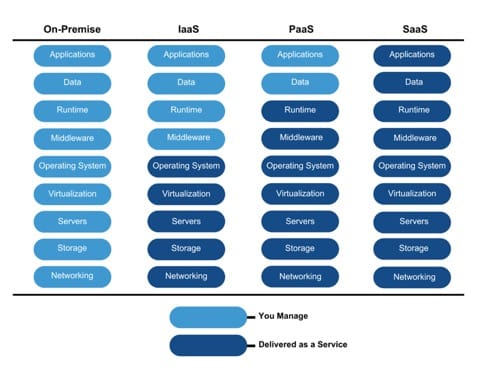Cloud computing has become a popular buzzword in the tech industry, promising flexibility, scalability, and cost-efficiency for businesses of all sizes. One of an organization’s key decisions when moving to the cloud is choosing the service model that best suits its needs. There are three primary cloud service models: Infrastructure as a Service (IaaS), Platform as a Service (PaaS), and Software as a Service (SaaS). Each cloud computing service model offers a different level of control, management, and responsibility for the user. Let’s look at these models to understand their differences and benefits better.
Understanding Cloud Service Models: IaaS, PaaS, SaaS
Infrastructure as a Service (IaaS):
IaaS empowers users with virtualized computing resources over the internet. This includes virtualized hardware, storage, and networking resources, allowing users to deploy and manage their own virtual machines, storage, and networking. With IaaS, users have full control over the operating systems, applications, and middleware running on the infrastructure, giving them the confidence to customize their environments according to their specific requirements.
Popular IaaS providers include –
- Amazon Web Services (AWS)
- Microsoft Azure
- Google Cloud Platform
- IBM Cloud
When using Infrastructure as a Service (IaaS), users need technical networking, security, and virtualization expertise. They manage virtual machines, operating systems, and applications, including regular maintenance, updates, and security. Over-provisioning can lead to unnecessary costs, so careful resource monitoring is essential. Users must also ensure the security of their systems and data and may face challenges if they need to switch providers due to vendor-specific configurations and dependencies.
Platform as a Service (PaaS):
PaaS offers a platform allowing customers to develop, run, and manage applications without the complexity of building and maintaining the infrastructure typically associated with developing and launching an app. PaaS providers offer a complete platform for developers to build, deploy, and manage applications, including tools for testing, development, and deployment. This allows developers to focus on writing code and building applications without worrying about the underlying infrastructure.
Examples of PaaS providers include –
- Heroku
- Google App Engine
- Microsoft Azure App Service
- Apache Stratos
When considering Platform as a Service (PaaS), it’s essential to keep several key aspects in mind. First, PaaS may limit your control over the underlying cloud infrastructure and environment, which can be a concern if you require specific configurations. Additionally, using a particular PaaS provider may lead to vendor lock-in, making it difficult to switch to a different provider in the future. Security and compliance are also important considerations when entrusting your data to a third-party PaaS provider. Furthermore, customization constraints and performance variability due to shared resources should be considered. Lastly, while PaaS can provide cost savings, it’s crucial to assess pricing models and potential long-term expenses thoroughly.
Software as a Service (SaaS):
SaaS delivers software applications over the internet on a subscription basis, offering users convenience and cost savings. With SaaS, users access software applications hosted by a third-party provider on the cloud. This eliminates the need for organizations to install, run, and maintain software on their own devices, making it an attractive option for businesses looking to reduce IT maintenance costs. SaaS applications are typically accessed through a web browser, and users only pay for the features and functionality they need.
Well-known SaaS offerings include –
- Salesforce
- Microsoft Office 365
- Google Workspace
- Zoom
- HubSpot
Software as a Service applications offer convenience and cost savings but have potential drawbacks. Internet dependence can hinder access in case of connectivity issues, and limited customization may not meet the unique needs of some businesses. Data security concerns arise due to off-site data storage, and long-term costs can accumulate over time. Potential downtime and compliance challenges add to the considerations when opting for SaaS solutions, particularly for industries with strict regulatory requirements.
What Solution is best for your business?
Cloud computing offers businesses flexibility, scalability, and cost-efficiency through Infrastructure as a Service (IaaS), Platform as a Service (PaaS), and Software as a Service (SaaS) models. Each model comes with its own set of benefits and considerations. Organizations should carefully evaluate their specific needs, technical capabilities, security requirements, and long-term costs before choosing a cloud service model. Selecting the right model can empower businesses to optimize their operations and drive innovation while effectively managing potential challenges.
Need help identifying the right solution for you? Schedule a meeting with IP Pathways
IP Pathways
Cloud Services | Managed Services | IT Solutions | IT Consulting
At IP Pathways, we understand how difficult it is to scale on your own. But what if you could move past the issues currently holding you back? Good news–you can! We identify opportunities in your organization to leverage technology to spark greater growth starting now. Our tailored solutions turn IT into a strategic investment rather than a cost center. With the right tech, you can move faster, innovate, and gain a competitive edge.
Our engineers have deep technical expertise and experience. They architect, implement, monitor, support, and manage custom technology solutions for organizations using only the highest-quality and best-in-class systems. As a result, projects are completed on time and within budget, ready to deliver the results you need to fuel your organization forward. Contact Us


